#Megalosauridae
Text

Celebrating 200 years of Megalosaurus bucklandii, a 6-meter-long theropod which lived 166 million years ago in the Middle Jurassic what is now southern England, and on February 20, 1824, was also the first genus of non-avian dinosaur ever to have been given a valid name.
#paleoart#dinosaur#dinosaurs#paleontology#palaeoart#paleoblr#paleoartists on tumblr#palaeontology#megalosaurus#megalosauridae#dinosauria#theropod dinosaur#dinosaur artwork#dinosaur art#dinosaurios#dinosaurio#dinosaur illustration#jurassic period
77 notes
·
View notes
Text

A dinosaur tooth of an indeterminate theropod, likely a megalosaurid from the Isalo III Formation in Ambondromamy, Madagascar. The morphology is comparable to Middle Jurassic megalosaurs from similar contemporary deposits such as Afrovenator.
#dinosaur#fossils#paleontology#palaeontology#paleo#palaeo#megalosauridae#theropod#jurassic#mesozoic#prehistoric#science#paleoblr#メガロサウルス科#恐竜#化石#古生物学
78 notes
·
View notes
Text

A young Duriavenator hesperis found the empty shell of a Garantiana sp. at the beach (Bajocian, 168 Ma, England).
#paleoart#palaeoart#art#dinosaur#dino#prehistoric#paleontology#palaeontology#digitalart#Duriavenator#Duriavenatorhesperis#Megalosaurinae#Megalosauridae#Theropoda#Theropod#Garantiana#Stephanoceratidae#Stephanoceratoidea#Ammonitida#Ammonoidea#Ammonite#Jurassic#paleoblr#palaeoblr#digital art
62 notes
·
View notes
Text

Megalosaurus bucklandii done in August for my friend's Birthday. This is the first non-avian dinosaur named (back in 1827). Since then, many specimens from Europe, North America and Africa have been attributed to it (among them Dilophosaurus, Carcharodontosaurus and even Plateosaurus), but today this species is limited to material from the Middle Jurassic of Oxfordshire (England). Initially, Megalosaurus was represented as a four-legged reptile, similar to a crocodile with the limbs of a large mammal. Now its appearance seems completely different. Despite its historical significance, Megalosaurus is still not well studied.
Paint Tool Sai 2.0, 2023.
#megalosaurus bucklandii#megalosaurus#torvosaurus#eustreptospondylus#megalosauridae#megalosauroidea#theropod#late jurassic#paleoart
19 notes
·
View notes
Text
Torvosaurus gurneyi, having a look around.

#torvosaurus#megalosauridae#dinosaur#paleoart#digital drawing#digital doodle#this was a bit rushed sorry
14 notes
·
View notes
Text

Species: Thanatotitan
Clade: Megalosauridae
Diet: Carnivorous
Size: 40-45 ft
Habitat: Desert Canyons and Oasis Forests
Threat Level: 5/5 (Highly Lethal)
Group Orientation: Solitary
Fun Facts:
Thanatotitan is the largest predatory dinosaur in Trithanas, and are commonly referred to as "death titans" by the arkians who live in fear of this great predator.
They were once great hunters of the northern jungles, but now roam further south in the Kimmeran desert. A landscape that offered so few prey meant that Thanatotitan required huge territories to hunt in. However, they are not afraid to explore new environments in search of prey, as they are commonly known to venture into the jungles from time to time.
Although it does not take much work to capture smaller prey, Thanatotitan prefers to use the element of surprise when it comes to hunting larger prey, using their teeth and a bone crushing bite to bring them down. They have a very high predator drive that helps them survive their environment, and have commonly attacked an entire arkian village if they have little other options available to them.
#the ainrann chronicles#dinosaurs#dinosaur art#dinosaur books#dinosaur fiction#dinosaur novels#paleo art#paleo fiction#thanatotitan#megalosaurus#megalosaur#megalosauridae
0 notes
Text
Lana Rhoades Oiled Up And Fucked
blexican yella boned diamond banks fucks her roomie
Gay asian gets pounded
Young brunette italian babe Ginevra Hollander pisses after hard fucking in the car by two guys
Foot fucking my wife for the first time until she cums
So big and black
Tiny Asian Vina Sky stuffed by a big cock
Ryder Skye and Rogue Moms fuck amazing son WTF
Aunty Hot Boob Show
Boquete gatinho
#Keokee#doyleys#callets#Glenolden#half-mumbled#appraisingly#noneligibility#concremation#choreas#prodistribution#ocean-girdled#plateworker#ekubo#self-levied#double-mindedness#spaniellike#Megalosauridae#troubadour#licentiation#placements
0 notes
Text
There is no dinosaur named Troodon
Sunday 23/4/23

Alaskan Troodontid - Julio Lacerda @paleoart
A brief sorry for not writing for a while. Had a lot on my mind and also just struggled to get that jump-start on my creativity again. But after having a bit of nerd-out at a friend recently, I have a dinosaur related thing to talk about today.
For anyone knee-deep into dinosaur stuff, they'd know about the popular stereotyping around small meat eating dinosaurs. The likes of "Raptors" are often portrayed as problem solvers; coordinated, and clever. And although most modern birds have more developed brains than extinct non-bird dinosaurs, the exception of Troodon is often brought up.
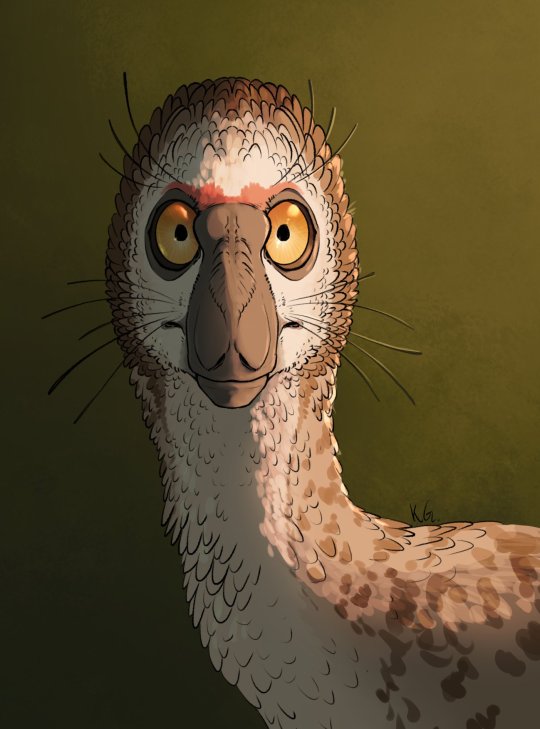
Troodon - @/the_meep_lord on Twitter
Troodon is a name that dino-nerds will bring up as a notable example of smart dinosaurs. It was one of the dinosaurs most closely related to birds, it had large eyes for its head, and in fact the largest brain to body size ratio of any non-avian dinosaur. But what many dino-nerds might struggle with, is that most palaeontologists believe that the genus Troodon is not valid.
Now when I first heard this information, my reaction was likely the same to yours reader. What do mean the genus isn't valid? Ask anyone what Troodon looks like, we have a very clear picture. How can we have full skeletons of a dinosaur that didn't exist? How come we have a significant clade of dinosaurs named after it (Troodontidae)? It is a dinosaur that even had unfortunate older stereotypes in its design (pictured below: the olive green smooth skinned Troodon that inspired the ugly Dinosauroid speculative biology thing).

llustration of Troodon - De Agostini Library (unable to find artist)
The issue, as I'll try to explain, was an unfortunate game of guesswork and generalisation across the Palaeontological community.
Discovery and Naming
In 1855, a single fossil teeth was found in Montana, USA. This was a particularly jagged tooth, and seemed to belong to some form of carnivorous or at least omnivorous reptile. It was named Troodon formosus meaning "wounding tooth, well formed". This tooth was originally classified as belonging to a lizard, so the genus Troodon was born.
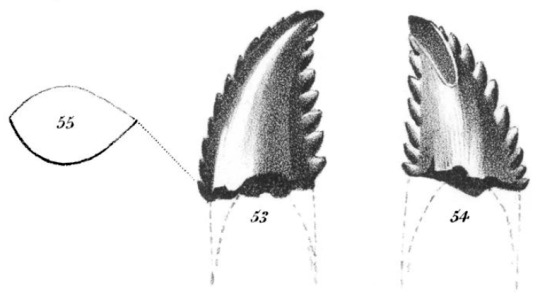
Troodon holotype drawing, 1860
In 1901, it was decided that Troodon's tooth belonged to a dinosaur, within the group Megalosauridae. But as I've discussed previously, Megalosaurus was a wastebasket taxon, and other experts wanted to place Troodon somewhere more definitive. In 1924, Troodon was classified as a relative of dome-headed dinosaurs such as Pachycephalosaurus and Stegoceras. And since Troodon pre-dated many dinosaurs in this group, the family was at the time referred to as Troodontidae.
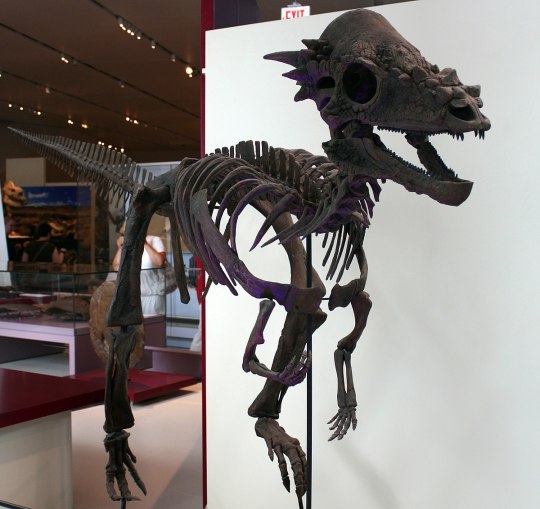
"Sandy", Pachycephalosaurus specimen at Royal Ontario Museum
Troodon as a Pachycephalosaur lasted until 1945, when Troodon was finally reclassified as carnivorous dinosaur, and the dome-headed dinosaurs were renamed under the title Pachycephalosauridae.
Other Troodontids
For a long time, the issue with Troodon was that because it's teeth were one of a kind, they did not know how the rest of it's body looked. The first dinosaur to be classified under Troodontidae that wasn't named just for teeth was a dinosaur called Stenonychosaurus (meaning 'narrow claw lizard").

Stenonychosaurus, Nix Illustration @alphynix
The original specimen of Stenonychosaurus did not have teeth, but it's close relative Saurornithoides did. And once both specimens had more complete specimens collected, they were classified under the group Saurornithoididae in the 1980s. But soon, scientists found similarities between the teeth of Saurornithoididae dinosaurs, and that of Troodon. The Principle of Priority states that earlier names for taxon are more valid taxonomically, so Saurornithoididae was considered synonymous with Troodontidae, and all specimens previously referred to as Stenonychosaurus were now called Troodon.

"Troodon" Specimen, Perot Museum, Texas
Most of the facts we now think of as Troodon were originally attributed to Stenonychosaurus, and many other North American Troodontids were considered as possible synonyms of Troodon, but this received some push back.
The idea that most of North America's Troodontids all belonging to one taxa was questioned. So, as had happened to other wastebasket taxon prior, Troodon was reanalysed.
In the late 2000s, a Troodontid called Pectinodon was separated from the Troodon genus and considered its own taxon. In the mid-late 2010s, some material originally classified under Stenonychosaurus, and then Troodon, was given its own genus, Latenivenatrix.

Latenivenatrix sculpture, @bookrat
Was "Troodon" really Troodon?
So the question of "What is a Troodontid?" had a very clear answer now. They were small to medium Theropod dinosaurs with narrow skulls, front facing eyes, larger braincases, and often restored with sickleclaws and feathers, similar to the Dromeosaurs. But the question came back to the Genus Troodon itself. We had sufficient material of many other Troodontids to tell what most of their body looked like, but the "holotype" of Troodon was still just one tooth.
In case you need a refresher on the terminology, a holotype is the first fossil a new species is named for. For another fossil to be named the same species, it needs to be identified as similar enough to the holotype. Holotypes are often fragmentary, it is common practice to fill in the full skeleton with details from similar relatives, but you still need enough details to identify who your relatives are.
The holotype of Troodon was so fragmentary, (again one bone), that it has been referred to as undiagnostic. Terminology lesson again, that means you CANNOT tell what it belongs to.

The fragmentary Holotype of the more recent Troodontid "Talos sampsoni", was almost complete in comparison to Troodon's. Credit: Scott Hartman
The Troodon tooth was *similar* enough to Stenonychosaurus that they were proposed to be close relatives, but there were differences enough for there to be initial scepticism at their synonymy. The original explanation proposed that the Troodon tooth came from an individual who was older, or in a different part of the mouth to teeth found from Stenonychosaurus, but this was never scientifically scrutinised, just proposed. The whole absorbing of Stenonychosaurus into Troodon was based on heresy that had never been scientifically tested.
So in 2017, almost universally, it was decided that Stenonychosaurus be separated from Troodon as its own valid dinosaur. Almost all material that had at that point been assigned to Troodon were reassigned to Stenonychosaurus or Latenivenatrix. And now the genus Troodon had a problem. If all known fossil material came down to a single, very undiagnostic tooth, then what WAS this dinosaur actually like?
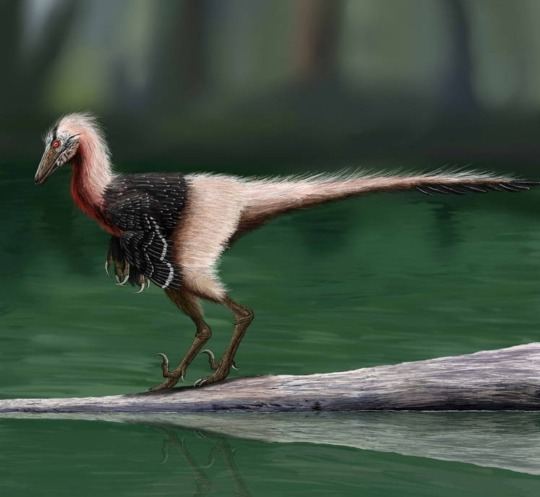
Stenonychosaurus - Anuperator (deviantart)
The current take is that there was no dinosaur known as Troodon in the technical sense. The tooth may not even belong to a Troodontid. But since Troodontidae has become an established group with established diagnostic traits, we still get to keep the name, for the group at least.
Troodontids Now
Troodontidae is still a very popular mainstream group of dinosaurs, but the names Stenonychosaurus, Saurornithoides, and Latenivenatrix are not as well known as Troodon. Many recent paleoart projects, particularly animations have depicted Troodon-like dinosaurs. But for scientific accuracy, they often decide to use the catch-all term "Troodontid", so audiences know what dinosaur we're talking about without being unscientific.
The YouTube Animation series "Dinosauria" features an episode on Arctic North American Dinosaurs. The main character is referred to as an Alaskan Troodon. This dinosaur has been originally proposed as a larger subspecies of Troodon described from larger teeth found in Alaska. As of writing, this Troodontid still does not an official description or scientific name.
youtube
In the 4th episode of the Apple TV+ series, Prehistoric Planet, we again see a dinosaur probably based on the Alaskan Troodon, this time just referred to as a "Troodontid".
youtube
In both pieces of media, the Troodontids engage in intelligent problem solving, but nothing on the level of what Jurassic Park would engage in. In Dinosauria, the Troodontid uses vocal mimicry. In Prehistoric Planet, it uses burning sticks to spread a wildfire. Both behaviours that different modern birds engage in, but may have been a stretch for what non-avian dinosaurs were capable of.
Thanks for Reading
If you are still a bit confused as to what this all meant, that's OK, it took me a while to get me head around it too. I encourage readers to do their own research and come to their own conclusion as to what this all means.
If you did feel my explanations helped you learn something new today, please reblog and spread the word. Of course add on your own commentary to the reblogs if you have insight that would better clarify the topic.
Thankyou for reading, and I'll hopefully have something else to post on here soon.
#blog#blogpost#palaeontology#dinosaurs#troodon#troodon formosus#stenonychosaurus#Latenivenatrix#Troodontidae#nomen dubium#theropod#Youtube#long post
80 notes
·
View notes
Text
Torvosaurus tanneri
('savage reptile, for Nathan Eldon Tanner')
Megalosauridae Megalosaurinae
At least 10 m long, and possibly as long as 12 m, Torvosaurus was an exceptionally large megalosaur, among the largest of the Jurassic's theropods found anywhere.
The genus is represented by two recognized species. The type species is T. tanneri, of the Morrison Formation of Colorado and Wyoming, USA. The second species is T. gurneyi ('for James Gurney') from the Lourinhã Formation of Portugal; T gurneyi is the largest known theropod from Europe. There is a possible third species from Germany waiting to be named.
Upper Jurassic, ~153 - 148 Ma.
~
Artwork by Robert Fabiani.
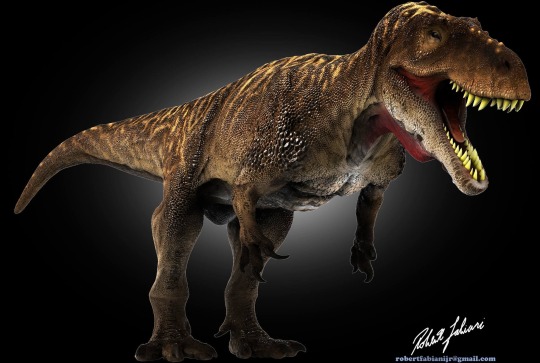
Daily Dino Fact #49
6 notes
·
View notes
Photo

It's time for Retro vs Modern Month!
Every weekday this March we'll be looking at some examples of how our paleontological understanding and visual depiction of various fossil creatures has evolved over the years.
Starting with…
Retro vs Modern #01: Megalosaurus bucklandii
Fragmentary fossil remains of dinosaurs have been found in Southeast England for hundreds of years, but it wasn't until the 1820s that they were properly recognized as belonging to an ancient "great lizard" given the name Megalosaurus bucklandii – the very first non-avian dinosaur known to science, almost two decades before the term "dinosaur" would even be created to categorize these extinct animals.
1850s
The Victorian Crystal Palace reconstruction of Megalosaurus is often mocked for its inaccurate bulky appearance, but for its time it was actually an incredibly progressive vision of a predatory dinosaur. It was depicted as an alert, active, bear-like beast with upright muscular limbs, and a humped back based on what later turned out to actually be remains of a different dinosaur species.
1890s-1960s
Discoveries of other large theropod dinosaurs revealed their bipedal posture, and Megalosaurus reconstructions were revised to show an upright kangaroo-like stance. But despite some other early portrayals of active agile dinosaurs, the overall opinion of these animals began to drift during the first half of the 20th century towards sluggish tail-dragging reptiles: depicting them as slow, stupid, cold-blooded, awkward and obsolete evolutionary failures whose extinction had been inevitable.
2020s
Starting in the late 1960s the Dinosaur Renaissance finally began to shift thinking back towards active and warm-blooded dinosaurs, recognizing theropods' close evolutionary relationship to modern birds and correcting their posture into a horizontal stance with a counterbalancing tail. And while Megalosaurus itself is still only known from fragments, discoveries of more completely preserved relatives like Torvosaurus have given us a much better idea of what it was probably like.
We know know Megalosaurus lived on what at the time was a subtropical island in the shallow western Tethys Sea, about 166 million years ago during the Mid Jurassic. It would have been around 8m long (~26'), with a long narrow snout, and short muscular arms with enlarged meathook-like thumb claws. Its legs and tail would have been fairly thick and bulky, and it may have had a covering of hair-like protofeathers on its body.
———
Nix Illustration | Tumblr | Twitter | Patreon
#retro vs modern 2022#science illustration#paleontology#paleoart#palaeoblr#megalosaurus#megalosauridae#megalosauroidea#carnosaur#theropod#dinosaur#art#retrosaurs
1K notes
·
View notes
Text

Day 9 for Dinovember - A torvosaurus takes a chance going after a lone brontosaurus.
EDIT, 1/11/22: This entire Dinovember series has been compiled and is now available for purchase on Gumroad! The pages can be printed, or thrown into a digital program! Check it out HERE!
#art#digital art#sketch#lineart#coloring book#dinovember coloring book#dinovember 2021#dinovember#dinosaur#dinosaurs#sauropod#diplodocidae#brontosaurus#theropod#megalosauridae#torvosaurus#morrison formation#late Jurassic
36 notes
·
View notes
Text

A dinosaur tooth of an indeterminate theropod from an unknown locale. It was labeled as possibly from the Yixian Formation, though the color of the preservation seems incorrect for this deposit, and does not seem to match Yutyrannus huali. The tooth has a midline distal serration density of 16/5mm and lacks a mesial carinae; the crown height is 20mm, CBL of 9.5mm, and CBW of 5.7mm. This type of morphology (lacking a mesial carinae) appears more consistent with Jurassic aged theropod teeth such as a megalosauroid which are known for short mesial carinae. There is a possibility that it belong to the Cretaceous carcharodontosaurian tooth taxon, Prodeinodon.
#dinosaur#fossils#paleontology#palaeontology#paleo#palaeo#yutyrannus#prodeinodon#proceratosauridae#tyrannosauridae#carcharodontosauridae#megalosauridae#theropod#cretaceous#jurassic#mesozoic#prehistoric#science#paleoblr#ユウティラヌス#プロデイノドン#プロケラトサウルス科#ティラノサウルス科#カルカロドントサウルス科#メガロサウルス科#恐竜#化石#古生物学
15 notes
·
View notes
Photo
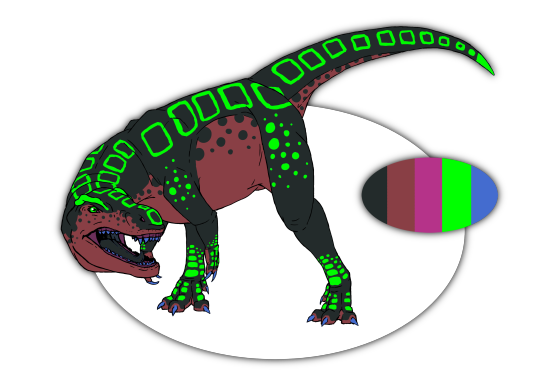
Hey!
And here he is the furious Torvosaurus, he is very mean and toxic to his environment and is not afraid to oppose even to the mighty tyrant king himself
Interesting dinosaurus indeed, I was pretty surprised when this guy pop up in the random generator :D I was expecting another herbivore but guess this guy had to be the first carnis that I had to draw :D
It was really fun making this piece even tho I had to take break for some time because I was really tired
Enjoy this bad boy ;3
And seen ya soon!
#torvosaurus#dinosaur#dino#digital#digital art#art#carnis#carnivore#prehistoric#prehistoric animals#pose#big lizard#lizard#savage#furious#theropod#Megalosauridae#torvosaurus tanneri
13 notes
·
View notes
Text

Afrovenator abakensis on yellow paper, from 2020. Afrovenator belongs to megalosaurids from the subfamily Afrovenatorinae. Its fairly complete remains, including a partial skull and most of its legs, were found in the Tiourarén Formation, Niger. Although it was initially thought that it lived in the Early Cretaceous, a more accurate dating places an animal in the Middle-Late Jurassic. Afrovenator is distinguished by a relatively graceful physique. According to the 2016 estimate, its length was 6.8 meters and its weight was 790 kilograms. This theropod lived together with the sauropod Jobaria, whose bones were mentioned in the same publication that contained the description of the Afrovenator.
Done with ballpoint and gel ink pens and black and white colored pencils.
#afrovenator abakensis#afrovenator#dubreuillosaurus#afrovenatorinae#megalosaurus#megalosauridae#jobaria#tiouraren formation#jurassic period#paleoart
22 notes
·
View notes
Text

Day 6: Megalosaurus bucklandii.
The first known non-avian dinosaur that ever discovered back in mid 1800’s before the time of Sir Richard Owen coin the word Dinosauria along with the third collection of latest finds such as this, iguanodon and Hylaeosaurus.
Based on skeletal design by Scott Hartman.
#megalosaurus#megalosauridae#theropoda#ornithoscelida#dinosauria#jurassic june#middle jurassic#paleoart#coloredpencil
10 notes
·
View notes
Photo

eustreptospondylus portrait by tnilab-ekneb121
13 notes
·
View notes